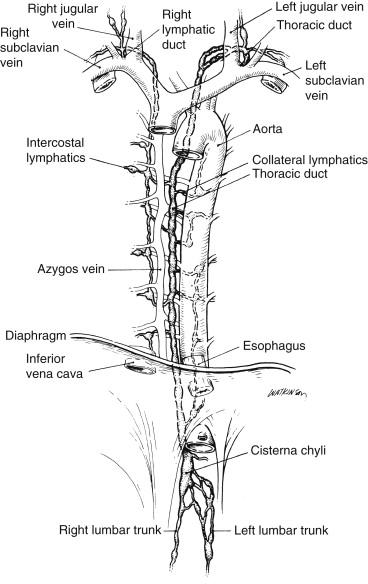Physical Address
304 North Cardinal St.
Dorchester Center, MA 02124
Chyloperitoneum and chylothorax are unusual but morbid conditions that were first recognized in the 17th century as complications of trauma. Each is caused by the formation of a fistula between the lymphatics and the peritoneal cavity or thoracic cavity, and they are both rare complications following aortic reconstruction. In 2008, Olthof and coworkers reported that of the 38 cases of chyloperitoneum following aortic reconstruction described in the literature between 1979 and 2007, approximately 50% of cases of chyloperitoneum followed elective abdominal aortic aneurysm repair, including 32% that followed emergency repair for a ruptured aortic aneurysm, 14% after surgery for aortic occlusive disease, and 5% after surgery for an infected graft. In a single-center review of 1233 descending thoracic aortic and thoracoabdominal aortic surgical repairs, Allahame and colleagues found only five patients (0.4%) who developed postoperative chylothorax, and of these, four had undergone an aortic reoperation.
Leakage of lymph during aortic reconstruction is common as lymphatic channels are transected or injured. After operation, damaged lymphatics most often heal spontaneously, and lymph continues centrally by way of multiple interconnecting lymphatic channels, resulting in no sequelae. It is postulated that for a chyloperitoneum or chylothorax to form, either a scarcity of lymphatic collaterals is present or the main lymphatic channels were injured previously, impeding collateral lymphatic flow. This can occur in the context of a variety of events, such as subclavian vein thrombosis, malignant invasion of the lymphatics, inflammatory reaction (tuberculosis, pancreatitis, cirrhosis, adhesions, and pulmonary fibrosis), or a prior operation near the thoracic duct or cisterna chyli. Regardless of the patient’s history, an understanding of the many anatomic variations in lymphatic drainage explains the low incidence of these complications.
The cisterna chyli forms posterolateral to the right of the aorta and anterior to the vertebral bodies of T12, L1, L2, and L3 as lymphatic channels from the mesentery, intercostals, and lumbar region join in the retroperitoneal space. At approximately L1, the ampullary cisterna chyli ascends, becoming the thoracic duct. The duct travels in a cephalad direction, crossing with the aorta into the thorax through the aortic hiatus. The duct then enters the right posterior mediastinum, crosses at T4 or T5 into the left retropleural space, and continues in a cephalad direction. The thoracic duct enters the venous system and empties the lymph into the blood stream ( Figure 1 ) where the left subclavian and internal jugular veins unite, 2 to 3 cm above the left clavicle. The thoracic duct enters the venous system and empties the lymph into the blood stream.

This system drains lymph from the entire body except the head, neck, arm, and thorax on the right side (which instead use the right bronchomediastinal, jugular, and subclavian lymph trunks to form the right lymph duct). Of the 4 L of lymph carried in the thoracic duct and cisterna chyli daily, more than 50% originates in intestinal and hepatic lymphatic channels. This is subject to great anatomic variation. Ikard documented that up to 50% of individuals did not have a distinct cisterna chyli, having instead a convergence of small lymphatic channels at the second lumbar vertebra to form the thoracic duct. These variations could play a role in the formation of chyloperitoneum and chylothorax after aortic reconstruction.
Become a Clinical Tree membership for Full access and enjoy Unlimited articles
If you are a member. Log in here